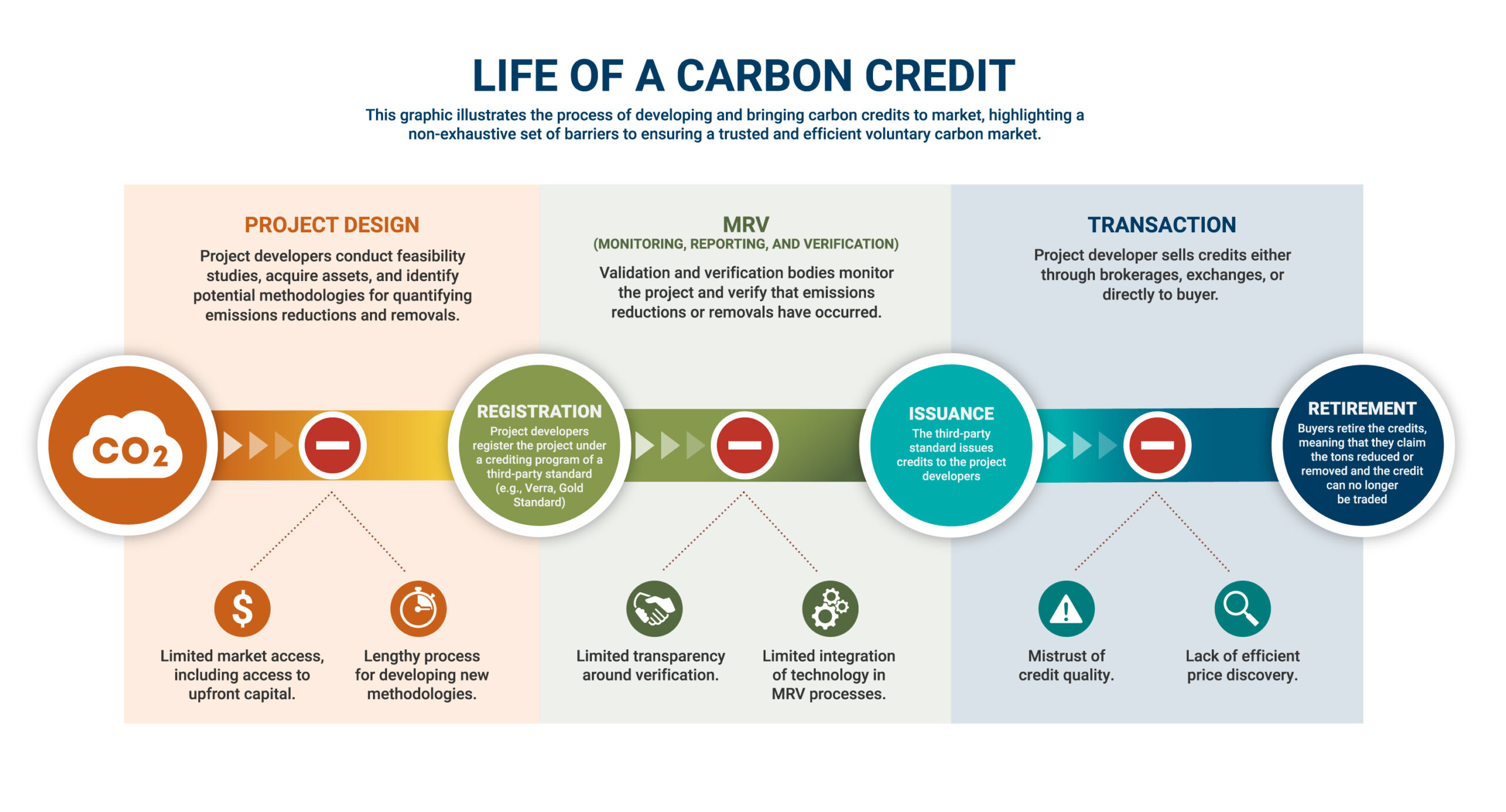
How to Build a Trusted Voluntary Carbon Market
The voluntary carbon market has a scarcity problem. While market transactions reached an all-time high in 2021, quadrupling from 2020 levels, this $2 billion, 400-million-ton market pales in comparison to the climate need: to avoid the worst impacts of climate change, we must reduce 420 gigatons (or billion tons) of global emissions by 2050 and remove 10-13 gigatons of emissions per year by 2050 while also protecting our natural carbon sinks.
The voluntary carbon market alone will not achieve these targets, but it can play a critical role in directing finance to emissions reduction and removal projects not otherwise supported by policy or investment — that is, if it can overcome widespread mistrust. Over the past few years, we have seen increasing scrutiny of the quality of carbon credits, as well as concerns that these credits will enable continued emissions from the fossil fuel industry. The message is clear: we must urgently restore trust in the market, ensuring that carbon credits are delivering high-quality emissions reductions and removals.
To tackle the twin challenges of scarcity and trust, we need to first understand how carbon credits are developed and brought to market. Drawing from interviews with 70+ organizations in the voluntary carbon market, we provide an overview of this process while also identifying three ways to unlock a trusted and high-quality carbon credit supply.
Life of a Carbon Credit
How does the voluntary carbon market work? The process for developing, transacting, and purchasing a credit varies depending on project type, who’s selling, and who’s buying. However, most credits pass through six stages:
- Project design: Most carbon credits begin with project developers, whose first task is to conduct a feasibility study and select a methodology for quantifying emissions reductions or removals. Project developers may choose a methodology already approved by a carbon crediting program, or they may propose their own methodology working with a carbon crediting program to accredit their methodology before the project begins.
- Registration: Following project design, the project developer must register the project under an accredited standard. There are four major carbon standards certifying credits in the voluntary carbon market (Verra, Gold Standard, Climate Action Reserve, and American Carbon Registry). A project is considered registered once it has been approved by a carbon standard to reduce emissions according to the project’s specific methodology.
- Monitoring, reporting, and verification (MRV): Following registration, a carbon project must undergo various MRV processes to ensure that it is in fact reducing or removing carbon. Project developers will monitor the emissions reductions achieved during the implementation period. For credits registered under one of the four major registries, project developers must contract third-party verifiers to ensure the accuracy of these claims.
- Issuance: Once the emissions reductions or removals have been verified, a project begins to issue carbon credits, each representing one ton of carbon dioxide equivalent (tCO2e).
- Transaction: The carbon credit now goes to market. Carbon credits typically reach buyers through one of three paths: 1) via offtake agreements, in which a buyer contracts directly with a project developer, 2) via brokers or other intermediaries, who purchase and resell the credit, and 3) via exchanges, which offer buyers a platform to access a pool of potential credits.
- Retirement: The final buyer of the carbon credit “retires” the carbon credit, meaning that this buyer has claimed the environmental benefit. The credit will be permanently removed from the market and can no longer be transacted. The time between issuance and retirement across the four major registries averaged six years in 2021, indicating that carbon credits are often sitting with brokers or other intermediaries for a significant duration before being purchased by the final buyer.
Carbon credits have been developed this way for the past two decades. However, the market is rapidly evolving, with new players seeking to redefine this process to tackle challenges around quality, transparency, and efficiency. Below, we identify three ways to accelerate the supply of high-quality carbon credits.
What is a carbon credit?
A carbon credit is a tradable good representing one ton of carbon dioxide equivalent (tCO2e) that has been reduced or removed from the atmosphere. Carbon credits are typically divided into two categories: those that avoid emissions (e.g., avoided deforestation, renewable energy, and energy efficiency) and those that remove emissions (e.g., reforestation and afforestation, engineered carbon dioxide removal), although some nature-based climate solutions may both avoid and remove emissions. Carbon credits are traded primarily on the voluntary carbon market, although they can sometimes be used in the context of compliance market (government-regulated markets driven by enforceable caps on greenhouse gas emissions). The term “carbon offset” is often used interchangeably with “carbon credit,” however, “offset” suggests the purchase of this good as an alternative to reducing one’s own emissions. RMI believes that credits must complement — rather than substitute for — direct decarbonization, and we therefore recommend the use of the term “carbon credit.”
Unlock 1: reduce the time and cost of project development
The time and capital requirements for developing a carbon project are constraining the supply of carbon credits. According to our interviews with project developers, it often takes at least two to three years for a project to begin issuing credits, and this period may be much longer for nature-based solutions or those developing new methodologies. The process of monitoring, reporting, and verifying credits can also be prohibitive for those seeking to bring credits to market; one study indicates that MRV expenses can amount to 20 to 30 percent of total credit revenue. Even if a project overcomes these barriers, it may face significant backlogs in registration.
We have identified two encouraging trends that address time and capital restraints. First, we’ve observed an increasing number of initiatives offering upfront capital to carbon credit projects. For example, advance market commitments and long-term offtake agreements are being deployed to create demand signals for emerging carbon removal and blue carbon solutions. Second, we recognize an increasingly prominent role for technologies such as satellites, LiDAR, and machine learning to not only improve the accuracy of measurements for carbon credit projects, but also reduce the time and cost of verification.
Unlock 2: differentiate the carbon credit supply
The carbon credit supply is highly heterogeneous — emissions reductions and removals come from different project types with varying risk levels, externalities, and co-benefits. This is a good thing. In order to achieve diverse objectives of reducing emissions, protecting natural carbon sinks, and removing carbon from the atmosphere, we need a voluntary carbon market that can support this level of differentiation. A differentiated market will not only help buyers sift through a diverse supply but will also provide the incentives to scale up high-quality projects.
Fortunately, several efforts are underway to differentiate the carbon credit supply. Over the past two years, ratings agencies have emerged to assess both the risk and the performance of carbon projects. Some are performing this service for corporate clients, while others are developing publicly accessible ratings. In addition, several initiatives focus on defining new standards for high-quality credits, including the Integrity Council for the Voluntary Carbon Market, which recently released its draft Core Carbon Principles, and the Carbon Credit Quality Initiative. Finally, existing standards are looking to differentiate their own supply through additional labels that indicate various attributes or quality levels.
Going one step further, we see an opportunity to differentiate the carbon credit supply based not only on the risks or quality of a credit, but also the range of externalities beyond the emissions impact. For example, we envision a carbon market that offers a premium for credits that promote biodiversity conservation and improved water quality. We also envision a carbon market that differentiates based on the quality or reliability of the MRV process. And we envision a carbon market that differentiates based on social equity and environmental justice, ensuring that carbon projects deliver benefits to local communities.
Unlock 3: enable a transparent voluntary carbon market
It is no secret that the voluntary carbon market has suffered from a lack of trust. Over the past couple of years of record growth, the voluntary carbon market has been the subject of countless articles and analyses on its shortcomings and risks. The market has responded primarily by seeking to strengthen (or create new) standards. However, we see an increasing need for a complementary strategy: the development of a platform with underlying data requirements that would provide radical transparency into the carbon credit supply.
While there are several platforms seeking to improve data quality and visibility in the market, many are commercially oriented. Furthermore, trust in these platforms often hinges on trust in their underlying quality standards and economic motivations. To overcome these limitations, we see the need for a platform built to enable complete data integrity and transparency for the carbon credit supply. This platform must not only provide complete visibility of carbon credit attributes and transactions, but also empower project developers and local communities to develop high-quality projects more quickly and cost-effectively.
What’s Next
In line with RMI’s “think, do, and scale” approach, our new Carbon Markets Initiative will develop research on how various cutting-edge technologies (e.g., blockchain, remote sensing, machine learning) can support a transparent and high-quality voluntary carbon market, while also examining ways that the market can promote social equity and environmental justice. Building on this research, we will also focus on developing the transparency platform needed to scale a trusted voluntary carbon market. We invite you to join us in this mission!
